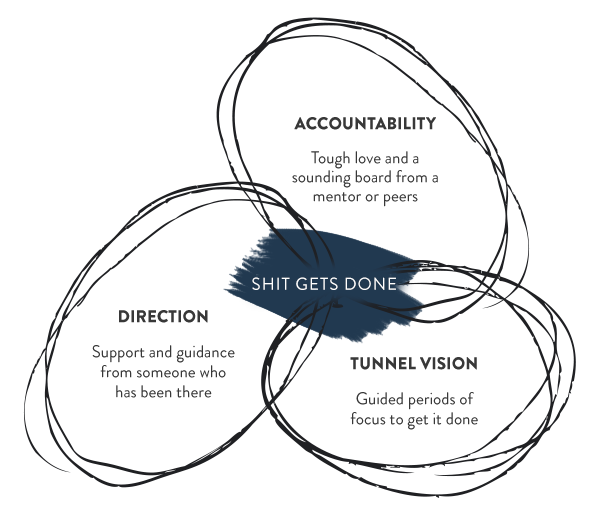It happens to the best of us. One day you’ll wake up and think… What am I actually doing? I have no clients, my last project fell flat and the thought of a stable salary is actually quite comforting right now.
Some snap out of it, most wallow in it and others give in. Your mojo; that fire of ambition that started you down this path in the first place is fading… fast.
You don’t always need to be failing either to feel that pain.
You may have clients; they just happen to be demanding sociopaths.
You may have cash coming in; just not enough spare for a vacation or to jump the ‘lifestyle ladder’.
Your skills may be developing; but you have this feeling you’ll never be in ‘his’ or ‘her’ league.
What am I actually doing?
Whether you find yourself lost on a plateau, caught in a temporary trough or staring into a 1,000 ft black hole there clearly is a problem. Take some comfort in the fact it’s normal, but don’t use it as an excuse.
In his book ‘The Dip’ Seth Godin describes this moment beautifully:
“The Dip is the long stretch between beginner’s luck and real accomplishment. The Dip is the set of artificial screens set up to keep people like you out.”
“Extraordinary benefits accrue to the tiny minority of people who are able to push just a tiny bit longer than most.”
Did you think that Superstar Freelancer Mary always had it this way? Has In-demand Dribbble Artist John always had a 6 month dream client wait list?
Fortunately for you, the answer is no.
Procrastination
I know my strengths; I’m a strategy guy with the various skills needed to execute them. Big picture, well-thought-out plans with the practitioner abilities and drive needed to make those plans happen.
It helped me get to where I am today. But I still get that feeling and I still procrastinate.
My version of procrastination is over-planning, over-big-picturing’ and waiting for the right moment rather than jumping on the ’Now moment’.
I wish I could be more Richard Branson… ‘Screw it, let’s do it’.
I’m more “Screw it, let’s do it – but I just need to confirm that the conversion rate and average order value would make it viable as a zzzz ….” (You get the picture).
You’ll often find in your life that this feeling you often have – let’s just call it ‘Me-No-Mojo’ for now – is a cover for procrastination. So it’s up to you to make adjustments to compensate for it.
For most of us then, the question really isn’t ‘What am I doing?’….
It’s actually more like this:
“I don’t know what I’m supposed to be doing, or what the next steps are to get better clients, more cash, better skills. I’m a bit stuck. Universe… help?”
 I truly believe that this feeling is linked to procrastination, a lack of direction and the absence of a plan which leaves you feeling aimless. Especially true if you’re already busy with client work.
I truly believe that this feeling is linked to procrastination, a lack of direction and the absence of a plan which leaves you feeling aimless. Especially true if you’re already busy with client work.
It’s the reason I dedicated a whole module (module two) of Freelancelift Pro to procrastination and why I talk at length about focus, as a key success trait.
Everybody procrastinates, here’s proof
In 2008 a group of cognitive psychologists held one of the most exhaustive studies known into procrastination, the results were very revealing and give us key insights into the ratlionalization techniques we all enlist to justify why a given task wasn’t completed.
Your ‘task’ in this instance is to put into place the actions that’ll take you down from the plateau, out from the trough or allow you to side step the black hole.
The study found also that while on the surface some delays may feel appropriate, we’re really just showcasing procrastination behavior under a different guise.
According to Tuckman, Abry, and Smith, there are 15 key reasons for procrastination:
1. Not knowing what needs to be done – “I didn’t know I was supposed to do that.”
2. Not knowing how to do something – “I don’t know how to do it.”
3. Not wanting to do something – “I really don’t want to do this.”
4. Not caring if it gets done or not – “It won’t make a difference whether I do this or not.”
5. Not caring when something gets done – “It really doesn’t make any difference if I put this off.”
6. Not feeling in the mood to do it – “I need to be in the mood. I’m not.”
7. Lacking the initiative to change or get started – “But I’ve always done it this way and it’s hard to change.”
8. Being in the habit of waiting until the last minute – “I know I can pull this out at the last minute.”
9. Believing that you work better under pressure – “I work better under pressure.”
10. Feeling stuck and unable to get to the next step – “I just can’t seem to get started.”
11. Forgetting – “I just forgot.”
12. Blaming sickness or poor health – “I couldn’t do it; I was sick.”
13. Waiting for the right moment – “I’m just waiting for the best time to do it.”
14. Needing time to think about the task – “I need time to think this through.”
15. Delaying one task in favor of working on another – “This other opportunity will never come again, so I can’t pass it up.”
I found the results fascinating, and I’m sure right now you can point to several of these reasons you’ve used today, or this week. This information though equips us with perspective.
If you know what to look for, and can identify procrastination ‘in progress’ you start to enter the right mindset for overcoming it.
Pushing through with positive action, looking at where you are right now objectively. Focusing on what really matters to change things. To get better clients, to generate more revenue, to sharpen your abilities.
What is the biggest step you could take right now; this very second, that would make even a small improvement?
Change things
Now is your chance to change things. I often link this sense of ‘Me-No-Mojo’ with a position I call ‘Maintenance Mode’. Most will find themselves there at some stage.
One of the most highlighted passages in the Kindle version of my book ‘Stop Thinking Like a Freelancer’ explains this phenomenon well:
“If you can’t immediately point to a specific action you took this week that furthered and evolved your business then you’ll probably find you’re in Maintenance Mode with your freelance career.
Stuck on a plateau, static financially yet furiously spinning the hamster wheel. Unclear on the most effective ‘to do’ action to tackle next.”
Even if you are doing okay though, and you are beyond Maintenance Mode could things be more efficient in the way you run the business? Could you procrastinate less? Could you get things done more quickly or build systems for subcontractors to help carry the load?
Positive Change
Consider this the start of a positive change in this area, it’s impractical to look for a full and final solution right now, you’ll only tie yourself in knots.
Instead consider this as just another step in your evolution. Remember, ‘getting better’ never ends, you just make real impact more consistently.

So you should consider this as another weapon in your arsenal. A resource to keep to one side whenever you feel distracted, stuck on a plateau or unclear on the next best steps to take. Like everything on Freelancelift it’s not a ‘one-hit’ resource, keep coming back to the content as you develop and you’ll get more out of it each time.
If you enjoyed these ideas you’ll probably like this previous post ‘The business side of freelancing and the 6 traits of those who succeed’
Learn anything? Please share
When you’re held ransom by client work and income instability how are you supposed to find time to work on “growth” (whatever that means).
- Make freelancing more stable
- Repel 'bad apple' clients
- Beat "treading water" cycles
- Multiply online exposure
Exclusively on Amazon







